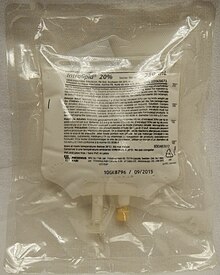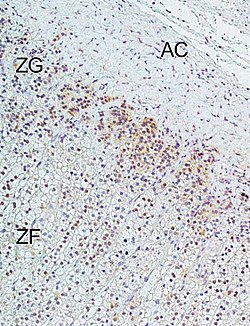Calcium channel blocker
| Calcium channel blockers | |
|---|---|
arrhythmia, cluster headache[1] | |
| ATC code | C08 |
| External links | |
| MeSH | D002121 |
| Legal status | |
| In Wikidata | |
Calcium channel blockers (CCB), calcium channel antagonists or calcium antagonists
CCBs have been shown to be slightly more effective than
Classes
Dihydropyridine

Dihydropyridine (DHP) calcium channel blockers are derived from the molecule
This CCB class is easily identified by the suffix "-dipine".
- Amlodipine (Norvasc)
- Aranidipine (Sapresta)
- Azelnidipine (Calblock)
- Barnidipine (HypoCa)
- Benidipine (Coniel)
- Cilnidipine (Atelec, Cinalong, Siscard) Not available in US
- Clevidipine (Cleviprex)
- Efonidipine (Landel)
- Felodipine (Plendil)
- Isradipine (DynaCirc, Prescal)
- Lacidipine (Motens, Lacipil)
- Lercanidipine (Zanidip)
- Manidipine (Calslot, Madipine)
- Nicardipine (Cardene, Carden SR)
- Nifedipine (Procardia, Adalat)
- Nilvadipine (Nivadil)
- blood-brain barrier and is used to prevent cerebral vasospasm.
- Nisoldipine (Baymycard, Sular, Syscor)
- Nitrendipine (Cardif, Nitrepin, Baylotensin)
- Pranidipine (Acalas)
Non-dihydropyridine
Phenylalkylamine

Phenylalkylamine calcium channel blockers are relatively selective for myocardium, reduce myocardial oxygen demand and reverse coronary vasospasm, and are often used to treat angina. They have minimal vasodilatory effects compared with dihydropyridines and therefore cause less reflex tachycardia, making it appealing for treatment of angina, where tachycardia can be the most significant contributor to the heart's need for oxygen. Therefore, as vasodilation is minimal with the phenylalkylamines, the major mechanism of action is causing negative inotropy. Phenylalkylamines are thought to access calcium channels from the intracellular side, although the evidence is somewhat mixed.[10]
- Fendiline
- Gallopamil
- Verapamil (Calan, Isoptin)
Benzothiazepine

Benzothiazepine calcium channel blockers belong to the benzothiazepine class of compounds and are an intermediate class between phenylalkylamine and dihydropyridines in their selectivity for vascular calcium channels. By having both cardiac depressant and vasodilator actions, benzothiazepines are able to reduce arterial pressure without producing the same degree of reflex cardiac stimulation caused by dihydropyridines.
- Diltiazem (Cardizem) (also used experimentally to prevent migraine)[citation needed]
Nonselective
While most of the agents listed above are relatively selective, there are additional agents that are considered nonselective. These include mibefradil, bepridil, flunarizine (BBB crossing), fluspirilene (BBB crossing),[11] and fendiline.[12]
Others
Gabapentinoids, such as gabapentin and pregabalin, are selective blockers of α2δ subunit-containing voltage-gated calcium channels. They are used primarily to treat epilepsy and neuropathic pain.[13]
Ziconotide, a peptide compound derived from the omega-conotoxin, is a selective N-type calcium channel blocker that has potent analgesic properties that are equivalent to approximate 1,000 times that of morphine. It must be delivered via the intrathecal (directly into the cerebrospinal fluid) route via an intrathecal infusion pump.[14]
Naturally occurring compounds and elements such as magnesium have also been shown to act as calcium channel blockers when administered orally.[15]
Side effects
Side effects of these drugs may include but are not limited to:
- Constipation
- Peripheral edema, which can occur in as much as 70% of people receiving calcium channel blocker, is caused by calcium channel blockers' preferential arteriolar or precapillary dilation without commensurate dilation in the venous or postcapillary circulation.[16][17][18][19][20] Since lymphatic drainage relies on contraction of the smooth muscle inside the lymphatic vessel[21] supported by voltage-gated calcium channels, inhibition of voltage-gated calcium channel poses a threat towards lymphatic removal of interstitial fluid essential for normal lymphatic system functioning.[20] (See also: Lymphedema.)
- Gingival overgrowth
Toxicity

Mild CCB
Hyperinsulinemia-euglycemia therapy has emerged as a viable form of treatment.[22] Although the mechanism is unclear, increased insulin may mobilize glucose from peripheral tissues to serve as an alternative fuel source for the heart (the heart mainly relies on oxidation of fatty acids). Theoretical treatment with lipid emulsion therapy has been considered in severe cases, but is not yet standard of care.
Caution should be taken when using verapamil with a beta blocker due to the risk of severe bradycardia. If unsuccessful, ventricular pacing should be used.[23]
Non-medical calcium channel inhibitors
Ethanol

Research indicates
Studies done by Katsura et al. in 2006 on mouse cerebral cortical neurons, show the effects of prolonged ethanol exposure. Neurons were exposed to sustained ethanol concentrations of 50 mM for 3 days in vitro. Western blot and protein analysis were conducted to determine the relative amounts of VGCC subunit expression. α1C, α1D, and α2/δ1 subunits showed an increase of expression after sustained ethanol exposure. However, the β4 subunit showed a decrease. Furthermore, α1A, α1B, and α1F subunits did not alter in their relative expression. Thus, sustained ethanol exposure may participate in the development of ethanol dependence in neurons.[29]
Other experiments done by Malysz et al. have looked into ethanol effects on voltage-gated calcium channels on
current in DSM cells and induced muscle relaxation. Ethanol inhibits VGCCs and is involved in alcohol-induced relaxation of the urinary bladder.[30]
Agatoxin in spider venom
Research on the desert grass spider, Agelenopsis aperta, has shown that agatoxins IVA and IVB found in their venom selectively block calcium channels. These agatoxins are found in other spider species as well. Desert grass spider bites to insects result in rapid paralysis, but bites to humans are not considered medically significant.[31]
Mechanism of action

In the body's tissues, the concentration of calcium ions (Ca2+
) outside cells is normally about 10,000-fold higher than the concentration inside cells. Embedded in the membrane of some cells are calcium channels. When these cells receive a certain signal, the channels open, letting calcium rush into the cell. The resulting increase in intracellular calcium has different effects in different types of cells. Calcium channel blockers prevent or reduce the opening of these channels and thereby reduce these effects.[citation needed]
Several types of calcium channels occur, with a number of classes of blockers, but almost all of them preferentially or exclusively block the L-type voltage-gated calcium channel.[32]
- By acting on vascular smooth muscle, they reduce contraction of the arteries and cause an increase in arterial diameter, a phenomenon called vasodilation (CCBs do not work on venous smooth muscle).
- By acting on cardiac muscles (myocardium), they reduce the force of contraction of the heart.
- By slowing down the conduction of electrical activity within the heart, they slow down the heart beat.
- By blocking the calcium signal on adrenal cortex cells, they directly reduce aldosterone production, which correlates to lower blood pressure.
Since blood pressure is in intimate feedback with cardiac output and peripheral resistance, with relatively low blood pressure, the

Reducing the force of contraction of the myocardium is known as the negative
Slowing down the conduction of electrical activity within the heart, by blocking the calcium channel during the plateau phase of the action potential of the heart (see: cardiac action potential), results in a negative chronotropic effect, or a lowering of heart rate. This can increase the potential for heart block. The negative chronotropic effects of CCBs make them a commonly used class of agents in individuals with atrial fibrillation or flutter in whom control of the heart rate is generally a goal. Negative chronotropy can be beneficial when treating a variety of disease processes because lower heart rates represent lower cardiac oxygen requirements. Elevated heart rate can result in significantly higher "cardiac work", which can result in symptoms of angina.
The class of CCBs known as dihydropyridines mainly affect arterial vascular smooth muscle and lower blood pressure by causing vasodilation. The phenylalkylamine class of CCBs mainly affect the cells of the heart and have negative inotropic and negative chronotropic effects. The benzothiazepine class of CCBs combine effects of the other two classes.
Because of the negative inotropic effects, the nondihydropyridine calcium channel blockers should be avoided (or used with caution) in individuals with cardiomyopathy.[33]
Unlike
Ionic calcium is antagonized by magnesium ions in the nervous system. Because of this, bioavailable supplements of magnesium, possibly including magnesium chloride, magnesium lactate, and magnesium aspartate, may increase or enhance the effects of calcium channel blockade.[34]
N-type calcium channels are found in neurons and are involved in the release of neurotransmitter at synapses. Ziconotide is a selective blocker of these calcium channels and acts as an analgesic.[14]
History
Calcium channel blockers came into wide use in the 1960s,[35] having been first identified in the lab of German pharmacologist Albrecht Fleckenstein in 1964.[36]
References
- PMID 19125880.
- ISBN 978-0-07-166833-0.
- ^ "calcium channel blocker" at Dorland's Medical Dictionary
- .
- ^ S2CID 23622821.
- PMID 20687074.
- ^ "Calcium Channel Blockers". MedicineNet. p. 2. Archived from the original on 2012-04-21. Retrieved 2013-01-19.
- ^ Norman M Kaplan, MD, Burton D Rose, MD (Apr 3, 2000). "Major side effects and safety of calcium channel blockers". Chinese Medical & Biological Information. Archived from the original on December 30, 2011. Retrieved July 23, 2012.
- PMID 11948275.
- S2CID 16275155.
- PMID 7565636.
- PMID 1755331.
- PMID 26362469.
- ^ PMID 26856969.
- PMID 22051430.
- PMID 12939574.
- ^ "Calcium-Channel Blockers (CCBs)". CV Pharmacology. Retrieved 2020-02-07.
- ^ Domenic A. Sica. "Calcium Channel Blocker-Related Peripheral Edema". Medscape. Retrieved 2019-10-26.
- ^ Matthew R. Weir. "Incidence of Pedal Edema Formation With Dihydropyridine Calcium". Medscape. Retrieved 2019-10-26.
- ^ S2CID 201094829.
- ^ Babak Mehrara. John F Eidt, Joseph L Mills Sr, Harold J Burstein, Kathryn A Collins (eds.). "Clinical features and diagnosis of peripheral lymphedema". UpToDate. Retrieved 2019-10-27.
- S2CID 32138463.
- .
- PMID 7521910.
- PMID 22934017.
- PMID 2112727.
- S2CID 28281696.
- S2CID 36172178.
- PMID 17031067.
- PMID 24153429.
- PMID 15066410.
- doi:10.1159/000497574. Archived from the original(PDF) on 2015-10-10. Retrieved 2013-06-29.
- ISBN 978-1-4160-6249-3.
- PMID 6375330.
- S2CID 42060942.
- PMID 6339106.
External links
- Calcium+Channel+Blockers at the U.S. National Library of Medicine Medical Subject Headings (MeSH)
- "Official Adalat (Nifedipine) site". Bayer. Archived from the original on 2008-04-08. Retrieved 2021-06-18.
- Video – Calcium Channel Blockers
